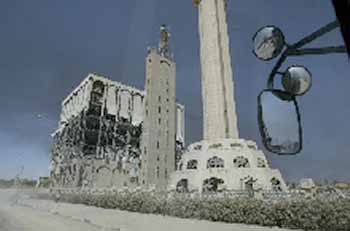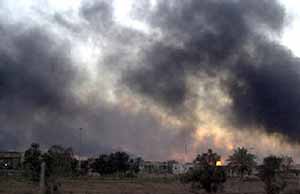At Umm Qasr, near Basra, the first ship arrived at the allied-controlled port with relief supplies for Iraqi civilians. The Sir Galahad, a British supply ship, carried 300 tons of water, sugar, beans, and flour.
The Army's senior ground commander in Iraq, Lt. Gen. William S. Wallace of V Corps, told reporters of The New York Times and Washington Post on Thursday that unexpected tactics by Iraqi fighters and stretched supply lines were slowing down the campaign. "The enemy we're fighting is different from the one we'd war-gamed against," the papers quoted Wallace as saying during a visit to the 101st Airborne Division headquarters in central Iraq. Brig. Gen. Vincent Brooks, at the daily briefing at U.S. Central Command in Qatar, insisted U.S. war planners had not underestimated Iraqi fighting capabilities, but said unexpected developments were inevitable in any war. He accused the Iraqis of using "terrorist death squads" who changed in and out of civilian clothes. Brooks also said U.S. and British troops were expanding TV and radio broadcasts in Iraq, including Baghdad, aimed at reassuring civilians and encouraging soldiers to capitulate. In one of the areas where resistance has been unexpectedly tough, U.S. Marines and Iraqi forces exchanged tank and artillery fire Friday in the strategic southern city of An Nasiriyah. Several buildings, including the power plant, were ablaze. An Nasiriyah, on the Euphrates River near a junction of roads that lead from Kuwait to Baghdad, has been the scene of some of the fiercest fighting of the war. Near the south-central city of Ad Diwaniyah, one Marine was killed and another injured in fighting with Iraqi irregulars at a cement plant in what one Marine officer, Lt. Col. B.P. McCoy, described as "blue-collar warfare." Two other Marines were killed when a vehicle ran them over while they slept. In Baghdad, smoke drifted across the city - from fires started by authorities to conceal targets as well as from sites struck overnight in one of the heaviest allied air assaults of the war. U.S. officials said bombs and Tomahawk missiles struck several communications and command-and-control facilities in the city, including the tower hit by two "bunker-busters" dropped from a B-2 bomber. One of Baghdad's main telephone exchanges - a seven-story building - was hit and gutted, but phones were working Friday in many parts of the city. Iraqi Information Minister Mohammed Saeed al Sahhaf told reporters that 75 civilians had been killed and 290 wounded in U.S. and British bombardments overnight, including seven deaths in Baghdad. He also said Iraqi forces destroyed or damaged several allied vehicles and killed four soldiers in an attack on a convoy near Najaf, less than 100 miles south of Baghdad. Sahhaf rejected allied contentions that Iraq planned to use chemical weapons - speculation that arose after advancing forces found chemical weapons protective suits and gas masks left behind by retreating soldiers. Sahhaf said having such equipment is standard for any army. Iraqi state TV broadcast a sermon by cleric Abdel-Ghafour Al-Quisi; a Kalashnikov rifle was seen resting against the pulpit. "May God install terror in the hearts of our enemies," he said. Nine days into the war, Pentagon officials said close to 90,000 U.S. troops were in Iraq, with 100,000 to 120,000 more on the way. Some will be deployed in northern Iraq, joining 1,000 airborne troops who parachuted in Wednesday night to secure an airfield. A paramount U.S. objective in the north is to seize the valuable oil fields near the city of Kirkuk, about 80 miles from the airdrop site. Russian President Vladimir Putin described the war Friday as a threat to global stability and the most serious crisis since the end of the Cold War. He called for an end to the fighting, and resumption of U.N. efforts to forge a political settlement.
|

